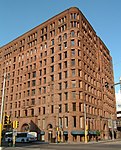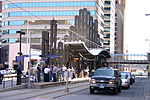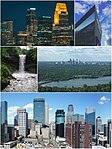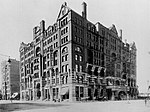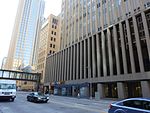Globe Building (Minneapolis)

The Globe Building was an 8 floor building in Minneapolis. It was the first recorded tallest building in Minnesota. It was built in 1889 to house the offices of the St. Paul Globe newspaper (which occupied part of several floors) while the remainder of the building was rented as office space. Richard Warren Sears was among its early tenants.After the newspaper folded in 1905 it continued to function as an office building and went on to count Senator Thomas Schall and Representative Ernest Lundeen among its tenants. By the 1930s the building sat vacant due to the poor economy and the general age of the building. In the 1940s it was briefly converted into a parking facility dubbed "The 4th Street Garage."It was demolished in 1958 and replaced by the Minneapolis Central Library, which opened in 1961.
Excerpt from the Wikipedia article Globe Building (Minneapolis) (License: CC BY-SA 3.0, Authors, Images).Globe Building (Minneapolis)
Hennepin Avenue, Minneapolis
Geographical coordinates (GPS) Address Nearby Places Show on map
Geographical coordinates (GPS)
| Latitude | Longitude |
|---|---|
| N 44.980369 ° | E -93.270423 ° |
Address
Minneapolis Central Library
Hennepin Avenue
55401 Minneapolis
Minnesota, United States
Open on Google Maps

